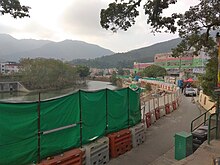




Ho Chung (Chinese: 蠔涌; Jyutping: hou4 cung1; Cantonese Yale: hòuh chūng) is a village on the Sai Kung Peninsula in Hong Kong. The Ho Chung River (蠔涌河) runs through the village.
Administration
Ho Chung is a recognized village under the New Territories Small House Policy.[1]
History
A Neolithic stone-working site was discovered at Ho Chung in 1999.[2]
The village was likely founded in the mid-16th century.[3]
Ho Chung was the centre of an inter-village grouping, the Ho Chung Tung (蠔涌洞) or Ho Chung Seven Villages (蠔涌七鄉). This grouping owned the Che Kung Temple at Ho Chung. It comprised the Punti villages of Ho Chung, Nam Pin Wai, Mok Tse Che, Tai Lam Wu (including its off-shoot Ngau Liu), Man Wo (including its off-shoot Chuk Yuen), Tai Po Tsai (on Clear Water Bay Peninsula), and Sheung Sze Wan (on Clearwater Bay Peninsula). Shek Pok Wai (石壆圍), considered as an off-shoot of Ho Chung, is also included.[3][4]
At the time of the 1911 census, the population of Ho Chung was 418; the number of males was 159. The population of Shek Pok Wai was 13; the number of males was 4.[5]
Austin Coates reported in 1955 that Nam Pin Wai was a "Cantonese hamlet, subsidiary of Ho Chung".[4]
Sights
The Che Kung Temple in Ho Chung, one of the two temples in Hong Kong dedicated to Che Kung,[6] is a Grade I Historic Building.[7]
The Chan Ancestral Hall, at No. 25 Ho Chung First Lane was built around the 1850s.[8] It is a Grade III Historic Building.[7]
Industrial buildings
Lee Kum Kee formerly had an oyster sauce and soy sauce factory in Ho Chung, adjacent to a Lee Seng Heng fish sauce factory. The Lee Kum Kee factory closed between 1996 and 1999, and by 2013 both sauce factories were noted to have been shuttered for years.[9] There is also a former multistory dye works, that was once used as an Asia Television studio.
See also
- Wo Mei, an adjacent village located south of Ho Chung.
References
- ^ "List of Recognized Villages under the New Territories Small House Policy" (PDF). Lands Department. September 2009.
- ^ Hong Kong 2006 Yearbook: Archaeological Background
- ^ a b Hase, Patrick (June 2003). The Historical Heritage of Ho Chung, Pak Kong, and Sha Kok Mei, Sai Kung (PDF) (article). S.Y. Consultancy Services Co. Ltd.
- ^ a b Hamilton, Eric; Schofield, Walter; Peplow, S. H.; Tsui, Paul; Coates, Austin; Hayes, James (2010). "Chapter 6. Sai Kung Peninsula". In Strickland, John (ed.). Southern District Officer Reports: Islands and Villages in Rural Hong Kong, 1910-60. Hong Kong University Press. pp. 217–218. ISBN 9789888028382.
- ^ Hase, Patrick (1996). "Traditional Life in the New Territories: The Evidence of the 1911 and 1921 Censuses" (PDF). Journal of the Royal Asiatic Society Hong Kong Branch. 36: 78-79. ISSN 1991-7295.
- ^ Antiquities and Monuments Offices - Introduction to 1444 Historic Buildings, p.34 Archived 2012-10-13 at the Wayback Machine
- ^ a b List of the 1,444 Historic Buildings with Assessment Results Archived 9 July 2011 at the Wayback Machine
- ^ Antiquities and Monuments Offices - Introduction to 1444 Historic Buildings, p.588 Archived 2012-10-13 at the Wayback Machine
- ^ "Town Planning Appeal No. 5 of 2011 IN THE MATTER of the Town Planning Ordinance, Cap. 131 and IN THE MATTER of an Appeal under section 17B of the Town Planning Ordinance, Cap. 131 by New Orient Development Limited" (PDF). 16 July 2013. Retrieved 15 June 2021.
Further reading
- Choi, C.C. (1990). "Studies on Hong Kong Jiao Festivals" (PDF). Journal of the Royal Asiatic Society Hong Kong Branch. 30: 26–43. ISSN 1991-7295.
- Hamilton, Eric; Schofield, Walter; Peplow, S. H.; Tsui, Paul; Coates, Austin; Hayes, James (2010). "Chapter 6. Sai Kung Peninsula". In Strickland, John (ed.). Southern District Officer Reports: Islands and Villages in Rural Hong Kong, 1910-60. Hong Kong University Press. pp. 217–218. ISBN 9789888028382.
External links
- Delineation of area of existing village Ho Chung (Sai Kung) for election of resident representative (2019 to 2022) (includes Ho Chung New Village and Nam Pin Wai)
- Press release "Significant archaeological discoveries from Ho Chung, Sai Kung", July 6, 1999
- Antiquities Advisory Board. Historic Building Appraisal. Che Kung Temple, Ho Chung Road Pictures
- Antiquities Advisory Board. Historic Building Appraisal. Chan Ancestral Hall, No. 25 Ho Chung First Lane Pictures
- Antiquities Advisory Board. Historic Building Appraisal. Nos. 6, 7, 8, 9 & 10 Nam Pin Wai Tsuen Pictures
- Antiquities Advisory Board. Historic Building Appraisal. Nos. 3, 4 & 5 Nam Pin Wai Tsuen Pictures


Recent Comments